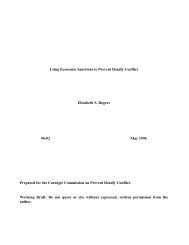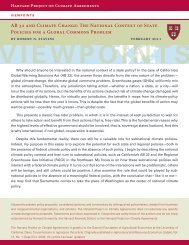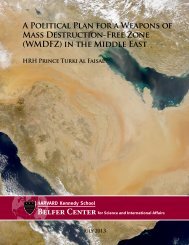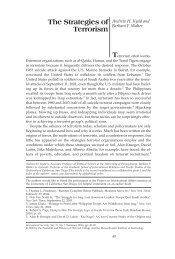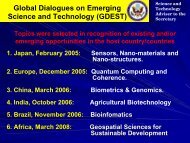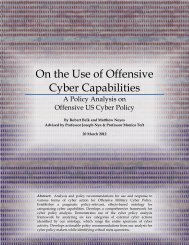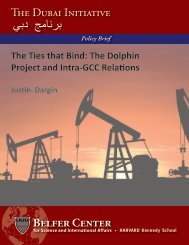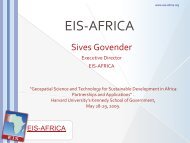Plutonium Mountain - Belfer Center for Science and International ...
Plutonium Mountain - Belfer Center for Science and International ...
Plutonium Mountain - Belfer Center for Science and International ...
- No tags were found...
Create successful ePaper yourself
Turn your PDF publications into a flip-book with our unique Google optimized e-Paper software.
• The United States, Kazakhstan, <strong>and</strong> Russia should make it a top priority to finish assessing<br />
the remaining plutonium <strong>and</strong> then securing whatever remains in vulnerable <strong>for</strong>ms.<br />
• Russia should take the lead in assessing <strong>and</strong> addressing similar issues that may exist at<br />
the other <strong>for</strong>mer Soviet nuclear test site. One hundred thirty nuclear explosions were carried<br />
out at the Novaya Zemlya site in Russia’s Arctic north. That test site is still active,<br />
conducting conventional blasts with nuclear materials that are permitted under the Comprehensive<br />
Test Ban Treaty, possibly including tests that could leave recoverable nuclear<br />
material behind. Much less is known about the legacy of testing there.<br />
• Test sites in other countries should be assessed as well. U.S. officials have concerns<br />
about the French testing site in the Algerian Sahara, <strong>and</strong> say that the French military has<br />
been uncooperative. 92 In the context of the nuclear security summit, the United States<br />
should seek to break through to the point where it feels ultimately reassured about the<br />
French test site. It seems plausible that testing sites in Pakistan, India, <strong>and</strong> North Korea<br />
may also pose a smaller threat—fewer <strong>and</strong> more primitive tests in these countries suggest<br />
that there is unlikely to be enough plutonium residue <strong>for</strong> a bomb, but ultimately no substantial<br />
amount of recoverable plutonium should be left unsecured anywhere in the world.<br />
• The history of the Soviet test site at Semipalatinsk should also push the international<br />
community to press <strong>for</strong> entry into <strong>for</strong>ce of the Comprehensive Test Ban Treaty, which the<br />
United States <strong>and</strong> several other nations have yet to ratify. The testing of nuclear weapons<br />
is a messy, dangerous business that undermines global security; a strong international<br />
norm against testing already exists. The international community should give that norm<br />
legal backing. The CTBT does not prohibit subcritical testing, which is still being carried<br />
out to support the safety, security, <strong>and</strong> reliability of nuclear stockpiles, <strong>and</strong> is likely<br />
to continue. But a clear lesson from Semipalatinsk is that such work must be conducted in<br />
an environment in which the fissile materials can be protected.<br />
4. Safeguards Forever<br />
While the concrete caps <strong>and</strong> plutonium-cement mixtures at Degelen <strong>Mountain</strong> have greatly reduced<br />
the proliferation risks posed by this plutonium, they have not eliminated them. Even <strong>for</strong><br />
the cemented plutonium, a state-backed enterprise might have the means to remove the plutonium,<br />
reprocess it, <strong>and</strong> reassemble it into a weapon. Indeed, this undertaking would likely be no<br />
more expensive or difficult than the conventional means of plutonium production, which requires<br />
the construction of a nuclear reactor <strong>and</strong> the reprocessing of spent fuel from the reactor. And<br />
even substantial non-state enterprises – like the major scavenging operations that were underway<br />
be<strong>for</strong>e – might someday be able to reach the plutonium, if monitoring of the site ceases.<br />
Legal mining operations within a few thous<strong>and</strong> meters of Degelen <strong>Mountain</strong> could be used to<br />
disguise a cl<strong>and</strong>estine operation. The United States <strong>and</strong> Russia may wish to push President Nazarbayev<br />
to exp<strong>and</strong> the exclusion zone around sensitive sites in Semipalatinsk. 93 President Naz-<br />
92<br />
Interview with Ristvet <strong>and</strong> other DTRA officials.<br />
93<br />
At the Seoul Nuclear Security Summit, Nazarbayev indicated that the threat reduction work at Semipalatinsk justifies the<br />
expansion of mining <strong>and</strong> development in the area. “All of the threats have been removed. The site exists today in totally different<br />
<strong>for</strong>m. Kazakhstan can look into the future without any concerns <strong>and</strong> develop this territory,” Nazarbayev told reporters at the<br />
summit. See: “’Russian-U.S.-Kazakh Cooperation on Semipaltinsk site an example how to h<strong>and</strong>le nuclear security’-Medvedev,”<br />
38<br />
<strong>Plutonium</strong> <strong>Mountain</strong>: Inside the 17-year mission to secure a dangerous legacy of Soviet nuclear testing



